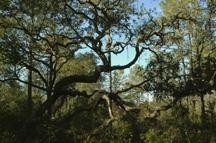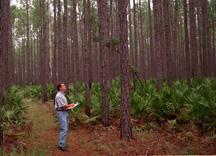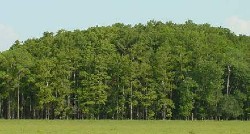Ecosystems
The Southeast features many different ecosystems. Explore them using the resources below.
-
Hardwood Hammocks

This diverse ecosystem is common on rolling terrain, and is characterized by thick stands of shade-tolerant hardwoods with a few pines mixed in. The soil is high in nutrients and contains more organic material and litter than drier sites. Some of the most common plants in this community include flowering dogwood, pignut hickory, laurel oak, American beautyberry, live oak, and Virginia creeper.
-
Pine Flatwoods

Pine flatwoods can be interspersed with smaller communities of wetland or cypress domes. Flatwoods can be identified by the level land and the consistent vegetation that includes slash pine, saw palmetto, wax myrtle, blackberry, and gallberry.
-
Wetlands
The term "wetlands" actually encompasses a few different water ecosystems. All are ecologically important because of their ability to reduce pollution levels by filtering and absorbing organic and inorganic chemicals from the water.
Swamps

Swamps occur along rivers and lakes and are mixed in with other communities such as pine flatwoods. Swamps are found in low-lying areas with poorly drained soils that are flooded part of the year. Plants in this ecosystem bear fruit at different times than upland plants, providing wildlife with a year-round food supply. Swamp plants include black gum, red maple, sweet bay, and bald cypress.
Marsh

Freshwater marshes are also found in low, flat, poorly drained areas and are dominated by rooted, herbaceous plants growing in shallow water. Fire plays an important role in this ecosystem. Without fire, marshes become replaced by forest plants and trees. Freshwater marsh plants include water lilies, pickerelweed, maidencane, and sawgrass.
Cypress Dome

Cypress domes are forested wetlands that are dominated by cypress trees. Here, groundcover plants are sparse due to prolonged water inundation. The term dome refers to the phenomenon in which larger trees grow in the center of the dome, and the trees get progressively smaller as they grow further from the center.
Cypress trees have developed an important adaptation in response to the water-logged soils in which they root: the roots produce "knees" that protrude above the soil and water. Although there are many theories about the function of the knees, many believe they are used for gas exchange. Cypress dome plants include pond cypress, red maple, buttonbush, bald cypress, and sweetgum.



